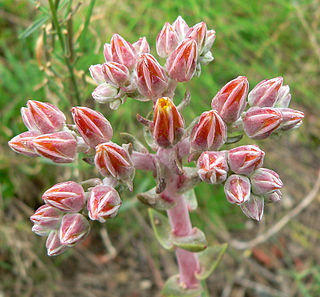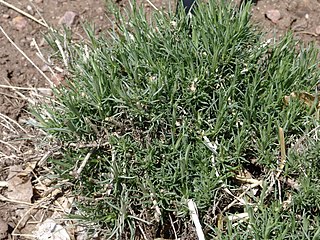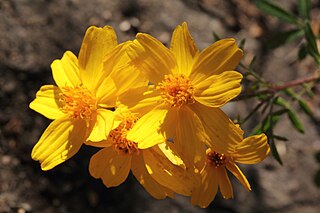
Nolina is a genus of tropical xerophytic flowering plants, with the principal distribution being in Mexico and extending into the southern United States. They are large, dioecious plants.

Sisyrinchium bellum, the western blue-eyed grass or Californian blue-eyed grass, is the common blue-eyed grass of California and Oregon in and west of the Sierra Nevada, its range extending south into Baja California. In parts of its range, western blue-eyed grass has previously been classified as Sisyrinchium eastwoodiae, S. greenei and S. hesperium, but these names are now considered synonyms.

Salix pentandra, the bay willow, is a species of willow native to northern Europe and northern Asia. The scientific name refers to the male flowers having five stamens. The English name derives from the resemblance of the leaves to those of the bay laurel; other common names include bay-leaved willow and laurel willow. Its glossy leaves make it more decorative than many other willows, so it is often planted as an ornamental tree.

Chrysothamnus, known as rabbitbrush, rabbitbush, and chamisa, are a genus of shrubs in the family Asteraceae. The native distribution is in the arid western United States, Canada, and northern Mexico. It is known for its bright white or yellow flowers in late summer.

Nolina parryi is a flowering plant that is native to Baja California, southern California and Arizona.

Nolina cismontana, the chaparral beargrass, chaparral nolina, California beargrass, Peninsular beargrass, or peninsular nolina, is a rare species of flowering plant of the Peninsular and Transverse Ranges in California. It is endemic to only four counties in Southern California: Los Angeles, Orange, San Diego and Ventura Counties. There are perhaps 15 to 17 occurrences in existence, with a total population estimated between 10,000 and 20,000.

Dudleya caespitosa is a succulent plant known by several common names, including sea lettuce, sand lettuce, and coast dudleya. It is endemic to California, where it grows along the coastline in the southern half of the state. Taxonomically, this species is a highly variable complex of polymorphic and polyploid plants, closely related to numerous neighboring species such as Dudleya farinosa, Dudleya greenei and Dudleya palmeri. It is delimited from neighboring species on an arbitrary basis of distribution and chromosome number, and may not be immediately separable from the other species it approaches.

Dudleya palmeri is a species of succulent plant in the family Crassulaceae known by the common name Palmer's liveforever. This Dudleya is endemic to California where it grows along the coast. It is characterized by orange to red over yellow or pink flowers. It is a polyploid species that closely resembles Dudleya lanceolata but has a coastal habit, and hybridizes with Dudleya caespitosa and Dudleya cymosa.

Dudleya greenei is a perennial species of succulent plant known by the common names Greene's liveforever, or Greene's dudleya. It is endemic to the Channel Islands of California, where it grows along the cliffs of four of the eight islands. It is a highly variable plant, presenting with multiple forms and varying levels of ploidy. Taxonomically, this species is an insular segregate of Dudleya caespitosa, and was placed as a stopgap taxon by Reid Moran in his 1951 thesis on the genus. It is characterized by white or green leaf rosettes, loomed over by inflorescences bearing pale yellow to white flowers. It is a member of the subgenus Dudleya, as it cannot be propagated from leaf cuttings, does not grow from a corm, and has tight petals.

Calochortus greenei is a species of flowering plant in the lily family known by the common name Greene's mariposa lily. It is native to northern California and southern Oregon, where it grows in the forest and woodlands of the mountains. It is a perennial herb which produces a branching stem up to about 30 centimeters in maximum height. There is a basal leaf about 20 centimeters long which does not wither at flowering. The inflorescence bears 1 to 5 erect bell-shaped flowers. Each flower has three sepals and three light purple petals with darker areas at the bases. The petals are 3 to 4 centimeters long and have a coat of long hairs on their inner surfaces. The fruit is a winged capsule about 2 centimeters long.
Collinsia greenei is a species of flowering plant in the plantain family known by the common name Greene's blue-eyed Mary.

Nolina interrata is a rare species of flowering plant known by the common names Dehesa nolina and Dehesa beargrass. It is known from about ten occurrences in central San Diego County, California, and fewer than 100 individual plants on land across the border in Baja California. The plant was first described in 1946 when found at the type locality near El Cajon, California, and all the individuals known in California are located within a six-square-mile area there. Although rare, numbering about 9,000 plants total in existence, the species is relatively well protected in its habitat and a proposal for federal protected status was withdrawn.

Silene campanulata is a species of flowering plant in the family Caryophyllaceae known by the common names Red Mountain catchfly and bell catchfly. It may be a synonym of Silene greenei.

Dudleya gnoma is a rare species of succulent plant in the stonecrop family known by the common names munchkin liveforever and munchkin dudleya. It is characterized by its diminutive stature, small yellow flowers, and distinctive white rosettes. It is endemic to the eastern portion of Santa Rosa Island, one of the Channel Islands of California, where it is known from one population at the type locality, containing three colonies of plants.

Nolina microcarpa is a species of flowering plant in the asparagus family known by the common names sacahuista and palmilla. Like other species of Nolina, it may be called beargrass. It is native to northern Mexico and the southwestern United States in Arizona and New Mexico. It does occur in the southwestern corner of Utah, where it has a limited distribution on Navajo Sandstone, but reports of it occurring in Texas may be in error.

Nolina erumpens, the foothill beargrass, mesa sacahuista, or sand beargrass, is a member of the subfamily Nolinaceae of family Asparagaceae, native to New Mexico, Texas and adjacent regions of north Mexico.

Chrysothamnus greenei, called Greene's rabbitbrush , is a North American species of flowering plants in the tribe Astereae within the family Asteraceae. It has been found in eastern California, Nevada, Arizona, New Mexico, Utah, Colorado, and southern Wyoming.
Erigeron greenei is a North American species of flowering plant in the family Asteraceae known by the common name Greene's narrow-leaved daisy .

Tagetes lemmonii, or Lemmon's marigold, is a North American species of shrubby marigold, in the family Asteraceae. Other English names for this plant include Copper Canyon daisy, mountain marigold, and Mexican marigold.

Nolina beldingii is a species of perennial flowering plant in the family Asparagaceae known commonly as the Cape nolina or Belding's beargrass. It is an arborescent monocot growing up to 7 metres (23 ft) high, with fissured bark on a trunk topped with leaf rosettes. The narrow leaves are up to 1.15 m (3.8 ft) long, and are used as thatching by local peoples. This species is endemic to Baja California Sur in Mexico, where it grows only in the highest reaches of the Sierra de la Laguna. It is found primarily in oak forests at elevations over 1,000 m (3,300 ft) along rocky granite outcrops.






















